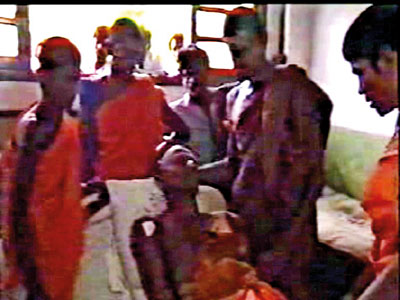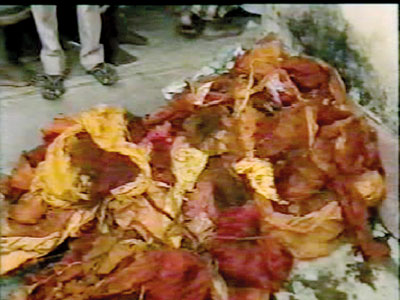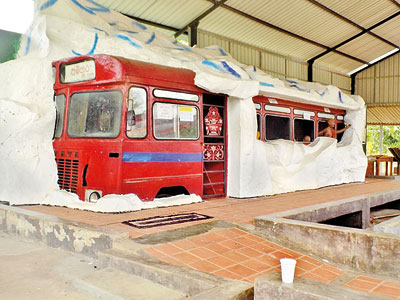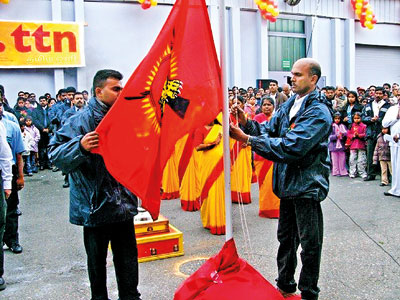Sunday Times 2
Slaughter of child monks at Aranthalawa, 35 years on: ‘Aney mamé, epa! Epa (Uncle, don’t, don’t), they pleaded
View(s):To mark the 35th anniversary of the Aranthalawa massacre, one of the most gruesome crimes committed by the LTTE on June 2, 1987, the Sunday Times carries excerpts from a research article by Sarita Gunaratna and Dinesh Jayakody.
The article is based on interviews with survivors, eyewitnesses, first responders, family members of victims and others with direct involvement or knowledge of this event, as well as the sworn statements and affidavits obtained by the Sri Lanka Armed Forces and police. The full article titled ‘The Saffron Children: And the Long Shadow of a Crime’ is published on our website timesonline.lk
On the night of June 01, 1987, in the Ampara District, Ven. Hegoda Sri Indasara Nayaka Thero arrived at Sri Vidyananda Pirivena in his van driven by his driver. There, the child monks were ready and waiting. After meeting with the child monks who were beyond excited about the next day’s trip, they all left the pirivena for the nearby Mahawapi Maha Vihare Temple at about 10pm by van. Here they were received with great excitement by the student monks residing there and the young ones fell into discussions with each other about the upcoming charikawa.
The early morning of June 02, 1987 was a happy one. The monks rose at 4am, before sunrise. The morning started with their usual religious activities in the Bo maluwa which included the daily commitments to their vows (precepts). After their meal, the teachers ushered the young monks to the Bo maluwa to complete their religious activities before the trip.
| Paltry compensation: Story of Siriyawathi After the massacre, the government offered one-time compensation to the victims’ families: Rs. 25,000 for the slain adults and Rs. 15,000 for the slain children. Even by 1987 standards, this was a paltry sum. Some families, such as Ven. Hegoda Sri Indasara Nayaka Thero’s family, rejected the offer. But, most of the families of the slain monks were poor to refuse it. The victims’ families have received no further assistance from the government or any form of reparations. The survivors, because they did not die in the massacre, received nothing at all. D. M Siriyawathi, mother Ven. Wavinne Aththadassi Thero who died in the massacre at the age of 17, noted that the entire government payment of Rs. 15,000 that her family received got used up in the process of obtaining her son’s death certificate. After the massacre, her once stable (although poor) family sank further and further into poverty, she said. Some years later, Siriyawathi’s husband passed away. Still, she continued to visit the pirivena when she could, which she had visited every two weeks for the three years that her son had resided there. The child monks reminded her of her own Podi Hamuduruwo (Little Monk), she said. The pirivena was the only institution that provided her with support after her son’s death. Whenever she visited, “The pirivena monks treat me very well.” She said tearfully. “They give me sugar, tea, flour to take back with me… what amount of money that they can give, telling me to use if for the bus fare, for medicine… They give me Panadol (pain medication), Siddhalepa (Ayurvedic balm)…” Much of Siriyawathi’s life was defined by loss. “Sri Lanka’s great years was in the 1960s and 70s.” She reflected. For a brief while in Sri Lanka’s modern history – wedged between two eras of violence: the colonial era and the war period – agrarian Sinhalese families enjoyed dignity, prosperity and opportunity. It was evident in “…the way we ate and drank and the way we lived.” She said. “Now there is only loss. I lost my Podi Hamuduruwo, I lost my husband, I lost my parents. I had to sell property to (be able to afford to) perform even a pinkama in their memory… I have not been able to regain my land.” Siriyawathi passed away in 2022, at the height of the financial crisis that resulted in island-wide shortages in medicine and medical supplies. Like many Sri Lankans without the financial resources to weather the many natural and man-made disasters of Sri Lanka, she died as she had lived, a victim of circumstances beyond her control. In May 2022, as hospitals across the country ran out of medicine, Siriyawathi was diagnosed with liver cancer and admitted into hospital. She died less than two weeks later. | |
Sometime after 5am, a distinctive red Sri Lanka Transport Board (SLTB) bus bearing the placard “Vishesha Charika” (Special Tour) arrived at the temple. Driver G. G. Samarapala was a dayakaya of the temple.
The monks in charge got the little ones seated inside the bus each clutching his round talipot leaf fan in one hand and a cloth travel bag in the other, which contained their worldly belongings: a spare robe, a black metal alms bowl, a needle and some thread and a parcel of food for lunch.
Eventually the bus filled up, with the monks sharing seats with each other because it was so full. Behind them was the Nayaka Thero’s white van which filled up with the remaining monks. Ven. Hegoda Sri Indasara Nayaka Thero walked to the Bo maluwa where he spent a few moments in solitude, offered merit to the devas, and took his leave from the temple. He then gave his last instructions to the two monks who remained at the temple and got into the bus last. He took the front seat next to a child monk, directly behind the steps.
At 5.45am, the bus left the temple with 43 monks, of whom 39 were child monks, and four lay folks. As the cool morning air blew through the open windows, the bus turned onto Ampara-Uhana Maha Oya Road. On the empty road, the bus picked up speed. Darkness gave way to bright Eastern daylight. The little monks started to sing folk songs. After a while of indulgence, Ven. Hegoda Sri Indasara Nayaka Thero with mock sternness reproached the group and instructed everyone to chant pirith with the same gusto with which they had sung the songs. Soon everyone was chanting pirith into the wind. The Eastern tropical sun was shining brightly through the open windows. The bus crossed from Ampara District into Batticaloa District as it raced towards Kandy. Everyone onboard was relaxed and happy.
Log placed across the road
SI Janaka Hapuhinna and his unit of STF officers who were stationed at the Mangalagama Camp had been patrolling the road by Mangalagama village since the night before. It was the last remaining Sinhalese village in Batticaloa, which he was assigned to protect from LTTE attacks. At some point early that morning, the STF personnel on duty observed the red bus bearing the placard “Vishesha Charika” head towards Maha Oya followed a little while later by a white van.

A survivor of the Aranthalawa Massacre surrounded by young monks at the Ampara Base Hospital. Images courtesy of the Sri Lanka Armed Forces
Around 7am the Chief Home Guard of the hamlet of Nuwaragaltenna, A. W. Jayawardene was having a cup of black tea at his home near the roadside. He had just finished the night “shift” with his team of Home Guards along the Ampara-Uhana Maha Oya Road. He caught a glimpse of the bus as it bounced along with the sound of monks chanting pirith inside.
At approximately 7.15am, the bus entered a desolate stretch of road that cut through a thick teak jungle known as Aranthalawa.
Suddenly, Samarapala pressed on the brakes and the bus slowed down to a stop. A log had been placed across the road blocking the path. Samarapala consulted with conductor Jinadasa. He suggested driving over the log, but Samarapala, perhaps sensing danger, started to put the bus into reverse.
Three men appeared on the side of the road wearing navy blue uniforms similar to those worn by the Sri Lanka Air Force. One of them, a well-built “tall and light-skinned” young man holding a T-56 assault rifle stepped up next to the bus and stuck out his hand, instructing the bus to stop.
Samarapala complied believing the man to be a member of the Security Forces, perhaps in need of a ride. The man climbed inside the bus with the two others. Pointing the machine gun at Samarapala and speaking in Tamil, he ordered the driver to turn the bus from the road towards the jungle. It was now apparent to all those in the bus that the person who had entered their bus was not a member of Sri Lankan Security Forces but a member of the LTTE organisation in disguise. Immediately, those on the bus became frightened. Samarapala, who was proficient in Tamil, spoke respectfully, explaining to the LTTE cadre that he was a civilian, the father of six children and that the bus was full of innocent child monks who were headed on a pilgrimage. “Please let us pass without trouble.” He begged. The LTTE cadre pointed his weapon threateningly at Samarapala’s mouth and shouted at him to turn the bus into the jungle immediately or face certain death. Perhaps fear took over or perhaps he believed that by following the terrorists’ orders, he would be able to save the lives of those on the bus. In either event, Samarapala made a fateful decision. He turned the bus away from the open road and towards a secretive place that had been prepared for them deep inside the teak jungle of Aranthalawa.

The robes worn by the Aranthalawa Massacre victims at the time of the attack. Image courtesy of Sri Lanka Armed Forces
With the weapon pointed at his face and body, Samarapala drove further and further into the jungle and away from the road. The small monks looked out of their windows and noticed that 25 to 30 LTTE cadres holding machine guns, swords, machetes, knives and poles had now positioned themselves on either side and behind the bus, and were following along silently on foot.
The bus continued to move forward extremely slowly. The children began to cry.
About 50 meters in, the LTTE leader onboard ordered Samarapala to stop the engine. Samarapala again complied. Another LTTE cadre boarded the bus as the one who had pointed the gun at Samarapala stepped off. He looked to be about 17 years old. “Munny munny woch woch” He shouted holding out a bag. The LTTE cadre moved through the bus, grabbing the wrist watches and wallets off of the lay folk. The monks also gave any money that they had on them, which was not much. With the loot secured in the bag, he too stepped off the bus. The first LTTE cadre stepped back on and pointed his machine gun again at Samarapala. Again Samarapala begged and pleaded with the LTTE cadre with his palms joined and fingers interlaced saying over and over again that he was the father of six children who would be left destitute were he to be killed. The LTTE cadre shot him multiple times in the head and Samarapala collapsed on the steering wheel.
Another LTTE cadre climbed in. It was immediately clear to everyone inside that he was carrying a sword. He was small made, well-built and dark-skinned, and had a “terrifying face and demeanor”. When the small monks saw him, they began to cry even louder.
Ven. Hegoda Sri Indasara Nayaka Thero perhaps sensing what was about to take place, stood up from his seat and said “I am Hegoda Indasara from Galle. I am not afraid to die. If you harbor hatred towards me, then kill me! But, do not harm these little ones.”
One of the cadres shouted at Ven. Hegoda Sri Indasara Nayaka Thero and pushed him back into the seat as the other swung the sword. The sword first hit the ceiling of the bus. Ven. Hegoda Sri Indasara Nayaka Thero attempted to block the falling blade with his arm, but it struck his head. Their beloved Head Monk Ven. Hegoda Sri Indasara Nayaka Thero, 59, crumpled into the seat and died.

The Aranthalawa Memorial: exterior view
The small monks began to scream. Some started to run here and there inside the bus. Some hid between seats. The LTTE cadres who had surrounded the bus watched silently, and waited. After Ven. Hegoda Sri Indasara Nayaka Thero had been killed, Ven. Valallawita Wimalanyana Thero who was seated directly behind, sensed that he would be next. He stood up and repelled the blade of the sword with his arm causing it to hit the roof of the bus. This blunted the force with which the sword came back down and saved his life. Ven. Valallawita Wimalanyana Thero slid to the ground as the blade sliced his hand, arm and chest in one deep long gash. He fell between seats.
In a final effort to escape death, some children begged their murderers SAney mamé, epa! Epa!A ( Uncle, donUt! Dontt!t) and )Aney ayyé, apiva maranna epa!A (Big brother, don t kill us!t).
Lying on the ground Ven. Valallawita Wimalanyana Thero watched blood flow “like a river” down the aisle. The LTTE cadres left the bus. He heard celebratory hoots and howls of laughter outside. Gunshots were fired into the air. Approximately 10 or 15 minutes after the massacre had started, it was over. The survivors would later describe their attackers as “practised” and “efficient”.
Those in the van escape
Nuwaragaltenna’s Chief Home Guard, Jayawardene, immediately sensed that something must have happened to the monks. Not long after the bus had bounced by carrying the pirith-chanting monks, he had heard gunshots in the distance. He sounded his siren (horn). The Home Guards who had wandered off towards their houses, quickly assembled within a few minutes of the siren’s call. Once the men had gathered, they returned to the side of the road and tried to figure out the location of the bursts of gunfire. A lorry came down the road and they flagged it down.
“Did you pass an SLTB bus carrying Buddhist monks going in the opposite direction?” Jayawardene asked the lorry driver. The driver said, no.
Jayawardene knew now that the monks were being attacked. He dispatched two of his men to the nearest STF camp in the lorry. The remaining 23 men, gripping a variety of weapons such as rifles, axes and poles, charged into the jungle, risking their own lives in the process. As they searched inside the dense jungle they could hear the sounds of gunshots and screaming. Jayawardene and his men fired their weapons as warning as they searched for the victims.

Aranthalawa butcher Regan raising the LTTE flag in Paris. Image courtesy of D.B.S. Jeyaraj.
Approximately 45 minutes after the bus and van had passed them, STF officers who had been on patrol near the Mangalagama camp saw the same white van they had seen previously driving behind the bus rush towards them at great speed. The driver pulled up next to the officers in a state of panic and explained that the bus carrying Ven. Hegoda Sri Indasara Nayaka Thero and many small Buddhist monks had been stopped by whom he initially thought were Sri Lankan Security Forces personnel. When the bus stopped, the driver had stopped the van, some distance away. At that point the men that stopped the bus had started shooting at the van, he said, but those inside the van were unharmed. He realized when the shooting happened that the people who had stopped the bus were LTTE cadres in disguise. As the panicked driver turned the van around as fast as he could and sped back towards the STF personnel, he had seen that the bus was turning left into the Aranthalawa jungle.
“How many LTTE cadres did you see?” SI Hapuhinna asked. The driver said that he thought he saw about eight men standing near the bus. SI Hapuhinna realised that a major attack on the monks was taking place. However, his unit had no vehicles with which to respond. They quickly flagged down lorries as and when they came along the road and climbed in or hung on the sides and rushed to the scene. Near Aranthalawa, they hopped off and ordered the lorries to remain on the side of the road. On foot the soldiers entered the jungle. They heard shooting going on to their right and moved towards the direction of the gunfire, firing as they advanced. Approximately 50 meters from where it had been diverted, the red bus with its windows blown out came into view. The bus was eerily quiet.
Of the 47 who boarded the bus that morning 34 were killed in the massacre. 31 of the dead were Buddhist monks, of whom 29 were child monks. Of the four lay people who had taken part as volunteers, three were killed.
Mainly through the monitoring of LTTE communication sets, the STF learned about the LTTE team that had carried out the attack. The name that featured prominently in the intercepted communications was an LTTE regional leader who went by the nom de guerre Regan, whom the STF identified as the operation’s leader and chief participant. He was identified as being part of a seasoned team of eight LTTE leaders in the East that operated out of Batticaloa. They were responsible for many of the attacks on civilians in the Eastern Province. The STF believed that Karuna Amman, as the LTTE commander of the Eastern Province, would have been aware of the attack.
A week after the attack the STF responded militarily, targeting the LTTE’s Eastern leaders. Using the communications monitoring from Kalawanchikudi, a small STF team of five led by SI Faizal Hadji carried out a targeted operation in the Unnichchai forest. The team ambushed an LTTE campsite and killed three of the eight LTTE leaders who had carried out the Aranthalawa Massacre. Two other LTTE leaders were killed in a subsequent targeted STF operation. However, Regan, identified by the STF as the Aranthalawa Massacre’s leader and main participant, remained elusive. Though injured in an operation, the LTTE leadership went to great lengths to keep Regan alive even sending him to South India for medical treatment one month after the attack, after the Indo-Sri Lanka Accord was signed in July 1987. The LTTE sent him to South India for medical treatment again in September 1990 after he was injured in another military operation.
Regan later sought and received political asylum in France where he lived in Paris under the name Nadarajah Matheenthiran, while maintaining a low profile. He was eventually granted French citizenship for having a “blemishless” record there. After a while, he became active again in the LTTE under the name Parithy and in 2002 took over LTTE’s leadership in France which was operating under the front organisation Tamil Coordinating Committee (TCC) which was responsible for extorting money from Tamils living in France as “taxes” for the LTTE. On November 08, 2012, Regan was shot and killed next to a bus stand in Paris by two unknown assailants on a motorcycle. French authorities believe that he was killed by members of a rival faction within the LTTE.

